The National Oceanic and Atmospheric Administration (NOAA) announced on the 16th that over the past year, more than 60% of the world’s coral reefs have been affected by sea surface temperature increases significant enough to cause coral bleaching. NOAA stated last month that due to the El Niño phenomenon, which resulted in elevated sea surface temperatures off the coast of South America, coral reefs experienced a large-scale bleaching event for the fourth time in history. According to the report released this time, approximately 60.5% of the world’s coral reefs have been affected, and this percentage is still increasing.
Derek Manzello of NOAA expressed strong concerns about the state of the world’s coral reefs during a press conference, stating, “From February 2023 to April 2024, significant coral bleaching has been documented in both the Northern and Southern Hemispheres of each major ocean basin.” There have been three previous instances of global coral bleaching events due to rising sea temperatures: in 1998, affecting 20% of coral reefs; in 2010, affecting 35%; and from 2014 to 2017, affecting 56.1%. According to Manzello, while the severity and persistence were at their worst from 2014 to 2017, the period from 2023 to 2024, the fourth occurrence, is likely to surpass records soon.
Researchers report that the 4th global bleaching event had a large-scale impact on at least 62 countries and regions, with recent reports even from India and Sri Lanka. NOAA notes that coral reefs in the Atlantic Ocean are particularly affected by rising sea temperatures, with 99.7% experiencing sea surface temperature increases at bleaching levels over the past year.
Coral reefs around the world, including those in the Florida Peninsula, the Caribbean Sea, Brazil, tropical regions of the eastern Pacific, South Pacific, Red Sea, Persian Gulf, and Australia’s Great Barrier Reef, are experiencing progressing bleaching due to record-breaking heat over the course of several months, posing a crisis. The National Oceanic and Atmospheric Administration (NOAA) announced the results of its thermal stress monitoring based on satellite observations on the 15th. This marks the second occurrence of widespread bleaching in the past decade.
Jennifer Koss, director of NOAA’s Coral Reef Conservation Program (CRCP) said, “Climate model predictions for coral reefs have been suggesting for years that bleaching impacts would increase in frequency and magnitude as the ocean warms.”

According to the World Wide Fund for Nature (WWF), coral reefs are relied upon for jobs, food, coastal protection from storms and erosion, among other things. Additionally, over a quarter of marine species depend on coral reefs as their habitat. NOAA warns that 30-50% of the world’s coral reefs have already been lost, and without bold intervention, coral reefs could completely disappear by the end of this century.
Similar Posts
Pepe Clarke of WWF stated, ““If we need a specific, visual, contemporary case of what’s at stake with every fraction of a degree warming, this is it. The scale and severity of the mass coral bleaching is clear evidence of the harm climate change is having right now. We must act urgently to stop burning fossil fuels or we will lose coral reefs worldwide, with devastating consequences for coastal communities and marine wildlife.”
“As the world’s oceans continue to warm, coral bleaching is becoming more frequent and severe,” Manzello said. “When these events are sufficiently severe or prolonged, they can cause coral mortality, which hurts the people who depend on the coral reefs for their livelihoods,” he added.
While the environment surrounding coral and the outlook for the future are challenging, NOAA explains that interventions against coral bleaching are making “significant progress.” Such measures include relocating coral larvae to deeper, cooler locations and installing shading to protect corals.


















